Identifying Themes and Patterns on Management of Horticultural Innovations with an Automated Text Analysis
Abstract
1. Introduction
2. Materials and Methods
2.1. Selection of Horticultural Innovation-Based Literature
2.2. Descriptive Analysis
- -
- 23 papers fall under the subject area “Agricultural and Biological Science” with 9 categories (Agronomy and Crop Science, Animal Science and Zoology, Aquatic Science, Ecology, Evolution, Behavior and Systematics, Food Science, Forestry, Horticulture, Plant Science, Soil Science);
- -
- 10 papers fall under the subject area “Environmental Science” with 9 categories (Ecology, Environmental Chemistry, Environmental Engineering, Environmental Science (Miscellaneous), Management, Monitoring, Policy and Law, Nature and Landscape Conservation, Pollution, Waste Management and Disposal, Water Science and Technology);
- -
- 6 papers are included within the subject area “Social Science” with 4 categories (Development, Education, Geography, Planning and Development, Sociology and Political Science);
- -
- 4 papers fall into the subject area “Economics, Econometrics and Finance” with the category “Economics and Econometrics” and in “Engineering” with 3 categories (Electrical and Electronic Engineering, General Engineering, Industrial and Manufacturing Engineering);
- -
- 3 papers are included within the subject area “Business, Management and Accounting” with 3 categories (Management Information Systems, Management of Technology and Innovation, and Strategy and Management) and in the subject area “Energy” with 2 categories (Energy Engineering and Power Technology, Renewable Energy, Sustainability and the Environment).
2.3. Automated Content Analysis
3. Results
3.1. 1st Theme: Innovations
3.2. 2nd Theme: Water
3.3. 3rd Theme: Urban
3.4. 4th Theme: Countries
3.5. 5th Theme: System
3.6. 6th Theme: Technology
4. Conclusions
Supplementary Materials
Author Contributions
Funding
Institutional Review Board Statement
Informed Consent Statement
Data Availability Statement
Conflicts of Interest
References
- United Nation, Department of Economic and Social Affairs, Population Division. World Population Prospects 2019: Highlights (ST/ESA/SER.A/423); United Nations: New York, NY, USA, 2019. [Google Scholar]
- Food and Agriculture Organization of the United Nations. Unlocking the Potential of Agricultural Innovation to achieve the Sustainable Development Goals. In Proceedings of the International Symposium on Agricultural Innovation for Family Farmers, Rome, Italy, 21–23 November 2018; p. 120. [Google Scholar]
- IICA (Inter-American Institute for Cooperation on Agriculture). Innovación Para la Cooperación Técnica en el IICA; Directorate of Technical Cooperation: San Jose, CR, USA, 2013. [Google Scholar]
- Food and Agriculture Organization of the United Nations. FAOSTAT Statistical Database; FAO: Rome, Italy, 2021. [Google Scholar]
- Ramos-Sandoval, R.; Álvarez-Coque, J.M.; Mas-Verdú, F. Innovative capabilities of users of agricultural R&D services. Reg. Sci. Policy Pract. 2019, 11, 295–305. [Google Scholar]
- Eriksson, T.; Halla, H.; Heikkilä, M.; Kalliomäki, H. Bridging entrepreneurial competencies and business model innovation: Insights on business renewal in the small horticulture businesses in Finland. Agric. Food Sci. 2019, 28, 112–125. [Google Scholar] [CrossRef]
- EU SCAR. Agricultural Knowledge and Innovation Systems towards the Future—A Foresight Paper; EU SCAR: Luxembourg, Brussels, 2015. [Google Scholar] [CrossRef]
- Sutherland, L.-A.; Madureira, L.; Dirimanova, V.; Bogusz, M.; Kania, J.; Vinohradnik, K.; Creaney, R.; Duckett, D.; Koehnen, T.; Knierim, A. New knowledge networks of small-scale farmers in Europe’s periphery. Land Use Policy 2017, 63, 428–439. [Google Scholar] [CrossRef]
- Haynes, E.; Garside, R.; Green, J.; Kelly, M.P.; Thomas, J.; Guell, C. Semi-automated text analytics for qualitative data synthesis. Res. Synth. Methods 2019, 10, 452–464. [Google Scholar] [CrossRef]
- Cheng, M.; Edwards, D. A comparative automated content analysis approach on the review of the sharing economy discourse in tourism and hospitality. Curr. Issues Tour. 2019, 22, 35–49. [Google Scholar] [CrossRef]
- González-Rubio, J.; Navarro-López, C.; López-Nájera, E.; López-Nájera, A.; Jiménez-Díaz, L.; Navarro-López, J.D.; Nájera, A. A Systematic Review and Meta-Analysis of Hospitalised Current Smokers and COVID-19. Int. J. Environ. Res. Public Health 2020, 17, 7394. [Google Scholar] [CrossRef] [PubMed]
- Giacomarra, M.; Galati, A.; Crescimanno, M.; Tinervia, S. The integration of quality and safety concerns in the wine industry: The role of third-party voluntary certifications. J. Clean. Prod. 2016, 112, 267–274. [Google Scholar] [CrossRef]
- Leonidou, E.; Christofi, M.; Vrontis, D.; Thrassou, A. An integrative framework of stakeholder engagement for innovation management and entrepreneurship development. J. Bus. Res. 2018, 119, 245–258. [Google Scholar] [CrossRef]
- Golbabaei, F.; Yigitcanlar, T.; Paz, A.; Bunker, J. Individual predictors of autonomous vehicle public acceptance and intention to use: A systematic review of the literature. J. Open Innov. Technol. Mark. Complex. 2020, 6, 106. [Google Scholar] [CrossRef]
- Maesano, G.; Di Vita, G.; Chinnici, G.; Pappalardo, G.; D’Amico, M. The Role of Credence Attributes in Consumer Choices of Sustainable Fish Products: A Review. Sustainability 2020, 12, 10008. [Google Scholar] [CrossRef]
- Crofts, K.; Bisman, J. Interrogating accountability: An illustration of the use of Leximancer software for qualitative data analysis. Qual. Res. Account. Manag. 2010, 7, 180–207. [Google Scholar] [CrossRef]
- Vidmar, D.; Marolt, M.; Pucihar, A. Information Technology for Business Sustainability: A Literature Review with Automated Content Analysis. Sustainability 2021, 13, 1192. [Google Scholar] [CrossRef]
- Beeferman, D.; Berger, A.; Lafferty, J. A model of lexical attraction and repulsion. In Proceedings of the 35th Annual Meeting of the Association for Computational Linguistics and Eighth Conference of the European Chapter of the Association for Computational Linguistics, Madrid, Spain, 7–11 July 1997; pp. 373–380. [Google Scholar]
- Smith, A.E.; Humphreys, M.S. Evaluation of unsupervised semantic mapping of natural language with Leximancer concept mapping. Behav. Res. Methods 2006, 38, 262–279. [Google Scholar] [CrossRef]
- Zimitat, C.A. Lexical Analysis of 1995, 2000 and 2005 Ascilite Conference Papers. In Proceedings of the 23rd Annual Conference of the Australasian Society for Computers in Learning in Tertiary Education. Who’s Learning? Whose Technology? Sydney, Australia, 3-6 December 2006; pp. 947–951. [Google Scholar]
- Leximancer. User GuideRelease 4.5; Leximancer Pty Ltd: Brisbane, Australia, 2018. [Google Scholar]
- Thomas, D.A. Searching for Significance in Unstructured Data: Text Mining with Leximancer. Eur. Educ. Res. J. 2014, 13, 235–256. [Google Scholar] [CrossRef]
- Gapp, R.; Stewart, H.; Harwood, I.; Woods, P. Discovering the Value in Using Leximancer for Complex Qualitative Data Analysis. In Proceedings of the British Academy of Management Conference, Liverpool, UK, 10–12 September 2013; pp. 1–6. [Google Scholar]
- Jones, G.E. La diffusione delle innovazioni e i processi decisionali in agricoltura. Riv. Econ. Agrar. 1992, 3, 353–369. [Google Scholar]
- Rogers, E.M. Categorizing the adopters of agricultural practices. Rural. Sociol. 1958, 23, 345–354. [Google Scholar]
- Edler, J.; Yeow, J. Connecting demand and supply: The role of intermediation in public procurement of innovation. Res. Policy 2016, 45, 414–426. [Google Scholar] [CrossRef]
- De Silva, M.; Howells, J.; Meyer, M. Innovation intermediaries and collaboration: Knowledge–based practices and internal value creation. Res. Policy 2018, 47, 70–87. [Google Scholar] [CrossRef]
- Midgley, G. Systemic Intervention: Philosophy, Methodology, and Practice; Kluwer/Plenum: New York, NY, USA, 2000. [Google Scholar]
- Bal, P.; Castellanet, C.; Pillot, D. Accompagner le Développment des Exploitations Agricoles: Faciliter L’émergence et la Diffusion des Innovations. In Mémento de L’agronome; Cirad-Gret: Montpellier, France, 2002; Volume 202, pp. 373–405. [Google Scholar]
- Roussy, C.; Ridier, A.; Chaib, K. Adoption D’innovations par les Agricolteurs: Role des Perceptions et des Préférences. INRA Fr. 2015, 35, hal-01209051. Available online: https://hal.archives-ouvertes.fr/hal-01209051 (accessed on 8 February 2021).
- Pannell, D.J.; Marshall, G.R.; Barr, N.; Curtis, A.; Vanclay, F.; Wilkinson, R. Understanding and promoting adoption of conservation practices by rural landholders. Aust. J. Exp. Agric. 2006, 46, 1407–1424. [Google Scholar] [CrossRef]
- Rickard, B.J.; Richards, T.J.; Yan, J. University licensing of patents for varietal innovations in agriculture. Agric. Econ. 2016, 47, 3–14. [Google Scholar] [CrossRef]
- Rogers, E.M. Diffusion of Innovations, 5th ed.; Free Press: New York, NY, USA, 2003. [Google Scholar]
- Hassinger, E. Stages in the adoption process. Rural Sociol. 1959, 24, 52–53. [Google Scholar]
- Schwartz, S.H.; Bilsky, W. Toward a universal psychological structure of human values. J. Pers. Soc. Psychol. 1987, 53, 550–562. [Google Scholar] [CrossRef]
- Wensing, J.; Carraresi, L.; Bröring, L. Do pro-environmental values, beliefs and norms drive farmers’ interest in novel practices fostering the Bioeconomy? J. Environ. Manag. 2019, 232, 858–867. [Google Scholar] [CrossRef] [PubMed]
- Mankad, A.; Loechel, B.; Measham, P.F. Psychosocial barriers and facilitators for area-wide management of fruit fly in southeastern Australia. Agron. Sustain. Dev. 2017, 37, 67. [Google Scholar] [CrossRef][Green Version]
- Mankad, A. Psychological influences on biosecurity control and farmer decision-making. A review. Agron Sustain. Dev. 2016, 36, 40. [Google Scholar] [CrossRef]
- Buurma, J.S.; van der Velden, N.J.A. New approach to Integrated Pest Management research with and for horticulture. A vision from and beyond economics. Crop Prot. 2017, 97, 94–100. [Google Scholar] [CrossRef]
- European Commission. The Future of Food and Farming. In Proceedings of the Communication from the Commission to the European Parliament, the Council, the European Economic and Social Committee and the Committee of the Regions (COM), Brussels, Switzerland, 29 November 2017. [Google Scholar]
- Food and Agriculture Organization of the United Nations (FAO). Water for Sustainable Food and Agriculture 2017. Available online: www.fao.org/3/a-i7959e.pdf (accessed on 8 February 2021).
- Abou Hadid, A.F. Assessment of Impacts, Adaptation and Vulnerability to Climate Change in North Africa: Food production and water resources. In A Final Report Submitted to Assessments of Impacts and Adaptations to Climate Change (AIACC); Project No. AF90; The International START Secretariat: Washington, DC, USA, 2006; Available online: http://www.start.org/Projects/AIACC_Project/Final%20Reports/Final%20Reports/FinalRept_AIACC_AF90.pdf (accessed on 8 February 2021).
- Nicola, S.; Pignata, G.; Ferrante, A.; Bulgari, R.; Cocetta, G.; Ertani, A. Water Use Efficiency in Greenhouse Systems and its Application in Horticulture. AgroLife Sci. J. 2020, 9, 248–262. [Google Scholar]
- Sambo, P.; Nicoletto, C.; Giro, A.; Pii, Y.; Valentinuzzi, F.; Mimmo, T.; Lugli, P.; Orzes, G.; Mazzetto, F.; Astolfi, S.; et al. Hydroponic Solutions for Soilless Production Systems: Issues and Opportunities in a Smart Agriculture Perspective. Front. Plant Sci. 2019, 10, 923. [Google Scholar] [CrossRef] [PubMed]
- Tzortzakis, N.; Nicola, S.; Savvas, D.; Voogt, W. Editorial: Soilless Cultivation Through an Intensive Crop Production Scheme. Management Strategies, Challenges and Future Directions. Front. Plant Sci. 2020, 11, 363. [Google Scholar] [CrossRef]
- Kalantari, F.; Mohd Tahir, O.; Akbari Joni, R.; Fatemi, E. Opportunities and Challenges in Sustainability of Vertical Farming: A Review. J. Landsc. Ecol. 2018, 11, 1. [Google Scholar] [CrossRef]
- García-Caparrós, P.; Llanderal, A.; Maksimovic, I.; Lao, M.T. Cascade cropping system with horticultural and ornamental plants under greenhouse conditions. Water 2018, 10, 125. [Google Scholar] [CrossRef]
- Azenkot, A. Water and irrigation. In Israel’s Agriculture; Moisa, S., Ed.; Israel-Ministry of Agriculture & Rural Development: Rishon LeTsiyon, Israel, 2006; pp. 18–19. [Google Scholar]
- Montesano, F.F.; Serio, F.; Mininni, C.; Signore, A.; Parente, A.; Santamaria, P. Tensiometer-based irrigation management of sub irrigated soilless tomato: Effects of substrate matric potential control on crop performance. Front Plant Sci. 2015, 6, 1150. [Google Scholar] [CrossRef]
- Pascual-Seva, N.; San Bautista, A.; López-Galarza, S.; Maroto, J.V.; Pascual, B. Response of drip-irrigated chufa (Cyperus esculentus L. var. sativus Boeck) to different planting configurations: Yield and irrigation water-use efficiency. Agric. Water Manag. 2016, 170, 140–147. [Google Scholar] [CrossRef]
- West, G.H.; Kovacs, K. Addressing groundwater declines with precision agriculture: An economic comparison of monitoring methods for variable-rate irrigation. Water 2017, 9, 28. [Google Scholar] [CrossRef]
- Trentacoste, E.R.; Connor, D.J.; Gómez-del-Campo, M. Row orientation: Applications to productivity and design of hedgerows in horticultural and olive orchards. Sci. Hortic. 2015, 187, 15–29. [Google Scholar] [CrossRef]
- Deligios, P.A.; Chergia, A.P.; Sanna, G.; Solinas, S.; Todde, G.; Narvarte, L.; Ledda, L. Climate change adaptation and water saving by innovative irrigation management applied on open field globe artichoke. Sci. Total Environ. 2019, 649, 461–472. [Google Scholar] [CrossRef] [PubMed]
- Amos, C.C.; Rahman, A.; Karim, F.; Gathenya, J.M. A scoping review of roof harvested rainwater usage in urban agriculture: Australia and Kenya in focus. J. Clean. Prod. 2018, 202, 174–190. [Google Scholar] [CrossRef]
- De Corato, U. Agricultural waste recycling in horticultural intensive farming systems by on-farm composting and compost-based tea application improves soil quality and plant health: A review under the perspective of a circular economy. Sci. Total Environ. 2020, 738, 139840. [Google Scholar] [CrossRef] [PubMed]
- Hickman, Z.A.; Reid, B.J. The co-application of earthworms (Dendrobaena veneta) and compost to increase hydrocarbon losses from diesel contaminated soils. Environ. Int. 2008, 34, 1016–1022. [Google Scholar] [CrossRef]
- Sotamenou, J.; Parrot, L. Sustainable urban agriculture and the adoption of composts in Cameroon. Int. J. Agric. Sustain. 2013, 11, 282–295. [Google Scholar] [CrossRef]
- Van Veenhuizen, R. Introduction: Cities farming for the future. Introduction. In Cities Farming for the Future: Urban Agriculture for Green and Productive Cities; Van Veenhuizen, R., Ed.; IIRR/RUAF Foundation/IDRC: Manilla, Philippines, 2006; pp. 1–18. [Google Scholar]
- Csortan, G.; Ward, J.; Roetman, P. Productivity, resource efficiency and financial savings: An investigation of the current capabilities and potential of South Australian home food gardens. PLoS ONE 2020, 15, e0230232. [Google Scholar] [CrossRef]
- O’Sullivan, C.A.; Bonnett, G.D.; McIntyre, C.L.; Hochman, Z.; Wasson, A.P. Strategies to improve the productivity, product diversity and profitability of urban agriculture. Agric. Syst. 2019, 174, 133–144. [Google Scholar] [CrossRef]
- Sanyé-Mengual, E.; Specht, K.; Grapsa, E.; Orsini, F.; Gianquinto, G. How can innovation in urban agriculture contribute to sustainability? A characterization and evaluation study from five Western European cities. Sustainability 2019, 11, 4221. [Google Scholar] [CrossRef]
- Sanyé-Mengual, E.; Orsini, F.; Gianquinto, G. Revisiting the sustainability concept of Urban Food Production from a stakeholders’ perspective. Sustainability 2018, 10, 2175. [Google Scholar] [CrossRef]
- Grard, B.J.P.; Chenu, C.; Manouchehri, N.; Houot, S.; Frascaria-Lacoste, N.; Aubry, C. Rooftop farming on urban waste provides many ecosystem services. Agron. Sustain. Dev. 2018, 38, 2. [Google Scholar] [CrossRef]
- Hamilton, A.J.; Burry, K.; Mok, H.F.; Barker, F.S.; Grove, J.R.; Williamson, V.G. Give peas a chance? Urban agriculture in developing countries. A review. Agron. Sustain. Dev. 2014, 34, 45–73. [Google Scholar] [CrossRef]
- Orsini, F.; Kahane, R.; Nono-Womdim, R.; Gianquinto, G. Urban agriculture in the developing world: A review. Agron. Sustain. Dev. 2013, 33, 695–720. [Google Scholar] [CrossRef]
- Corbould, C. Feeding the Cities: Is Urban Agriculture the Future of Food Security? Future Dir. Int. Strateg. Anal. Pap. 2013, 1–7. Available online: https://www.futuredirections.org.au/wp-content/uploads/2013/11/Urban_Agriculture-_Feeding_the_Cities_1Nov.pdf (accessed on 8 February 2021).
- Mok, H.-F.F.; Williamson, V.G.; Grove, J.R.; Burry, K.; Barker, S.F.; Hamilton, A.J. Strawberry fields forever? Urban agriculture in developed countries: A review. Agron. Sustain. Dev. 2014, 24, 21–43. [Google Scholar] [CrossRef]
- Dennis, M.; Armitage, R.P.; James, P. Appraisal of social-ecological innovation as an adaptive response by stakeholders to local conditions: Mapping stakeholder involvement in horticulture orientated green space management. Urban For. Urban Green. 2016, 18, 86–94. [Google Scholar] [CrossRef]
- Steensland, A.; Zeigler, M. Productivity in Agriculture for a Sustainable Future. In The Innovation Revolution in Agriculture; Campos, H., Ed.; Springer: Cham, Switzerland, 2021. [Google Scholar]
- Pretty, J.; Toulmin, C.; Williams, S. Sustainable intensification in African agriculture. Int. J. Agric. Sustain. 2011, 9, 5–24. [Google Scholar] [CrossRef]
- Gilioli, G.; Tikubet, G.; Herren, H.R.; Baumgärtner, J. Assessment of social-ecological transitions in a peri-urban Ethiopian farming community. Int. J. Agric. Sustain. 2015, 13, 204–221. [Google Scholar] [CrossRef]
- Acuña, T.B.; Monckton, D.; Boersma, M.; Bailey, A.; Gracie, A. Design and delivery of a masterclass in horticultural business. Int. J. Innov. Sci. Math. Educ. 2019, 27, 88–96. [Google Scholar] [CrossRef]
- World Bank. Enhancing Agricultural Innovation: How to Go Beyond the Strengthening of Research Systems; World Bank: Washington, DC, USA, 2007. [Google Scholar]
- Osano, H.M.; Koine, P.W. Role of foreign direct investment on technology transfer and economic growth in Kenya: A case of the energy sector. J. Innov. Entrep. 2016, 5, 31. [Google Scholar] [CrossRef]
- Tanzania Horticulture Association (TAHA). Scoping Project Tanzania Horticulture Industry Business Opportunities; Netherlands Enterprise Agency: Utrecht, The Netherlands, 2018. [Google Scholar]
- Ng’atigwa, A.A.; Hepelwa, A.; Yami, M.; Manyong, V. Assessment of factors influencing youth involvement in horticulture agribusiness in Tanzania: A case study of Njombe region. Agriculture 2020, 10, 287. [Google Scholar] [CrossRef]
- Oberoi, H.S.; Dinesh, M.R. Trends and innovations in value chain management of tropical fruits. J. Hortic. Sci. 2019, 14, 87–97. [Google Scholar] [CrossRef]
- Elabed, N.; Hadded, M. Effect of different substrates on growth, yield and quality of tomato by the use of geothermal water in the South of Tunisia. GPH Int. J. Agric. Res. 2018, 1, 14–30. [Google Scholar]
- Radhouani, A.; El Bekkay, M.; Ferchichi, A. Effect of substrate on vegetative growth, quantitative and qualitative production of muskmelon (Cucumis melo) conducted in soilless culture. Afr. J. Agric. Res. 2011, 6, 578–585. [Google Scholar]
- Dupré, M.; Michels, T.; Le Gal, P.-Y. Crop drivers in the shift from synthetic inputs to alternative practices in diversified farming systems. Eur. J. Agron. 2020, 120, 126146. [Google Scholar] [CrossRef]
- Röling, N. Conceptual and methodological developments in innovation. In Innovation Africa: Enriching Farmers’ Livelihoods; Sanginga, P.C., Waters-Bayer, A., Kaaria, S., Njuki, J., Wettasinha, C., Eds.; Earthscan: London, UK, 2009; pp. 9–34. [Google Scholar]
- Kruger, H. Helping local industries help themselves in a multi-level biosecurity world—Dealing with the impact of horticultural pests in the trade arena. NJAS Wagening J. Life Sci. 2017, 83, 1–11. [Google Scholar] [CrossRef]
- Juntti, M.; Downward, S.D. Interrogating sustainable productivism: Lessons from the ‘Almerían miracle’. Land Use Policy 2017, 66, 1–9. [Google Scholar] [CrossRef]
- Galdeano-Gómez, E.; Zepeda-Zepeda, J.A.; Pedra-Muñoz, L.; Vega-López, L.L. Family farm’s features influencing socio-economic sustainability: An analysis of the agri-food sector in southeast Spain. New Medit 2017, 16, 50–61. [Google Scholar]
- Al Atiri, R. Les efforts de modernisation de l’agricolture irriguée en Tunisie. Rev. H.T.E. 2004, 130, 12–18. [Google Scholar]
- Lewin, K.; Grabbe, P. Conduct, knowledge, and the acceptance of new values. J. Soc. Issues 1945, 1, 53–64. [Google Scholar] [CrossRef]
- Spielman, D.J.; Ekboir, J.; Davis, K.; Ochieng, C.M.O. An innovation systems perspective on strengthening agricultural education and training in sub-Saharan Africa. Agric. Syst. 2009, 98, 1–9. [Google Scholar] [CrossRef]
- Schut, M.; Klerkx, L.; Rodenburg, J.; Kayeke, J.; Raboanarielina, C.; Hinnou, L.C.; Adegbola, P.Y.; Van Ast, A.; Bastiaans, L. RAAIS: Rapid Appraisal of Agricultural Innovation Systems (Part I). A diagnostic tool for integrated analysis of complex problems and innovation capacity. Agric. Syst. 2015, 132, 1–11. [Google Scholar] [CrossRef]
- Menary, J.; Collier, R.; Seers, K. Innovation in the UK fresh produce sector: Identifying systemic problems and the move towards systemic facilitation. Agric. Syst. 2019, 176, 102675. [Google Scholar] [CrossRef]
- Klerkx, L.; Aarts, N.; Leeuwis, C. Adaptive management in agricultural innovation systems: The interactions between innovation networks and their environment. Agric. Syst. 2010, 103, 390–400. [Google Scholar] [CrossRef]
- Struik, P.C.; Klerkx, L.; van Huis, A.; Röling, N.G. Institutional change towards sustainable agriculture in West Africa. Int. J. Agric. Sustain. 2014, 12, 203–213. [Google Scholar] [CrossRef]
- Deffontaines, L.; Mottes, C.; Della Rossa, P.; Lesueur-Jannoyer, M.; Cattan, P. Le Bail, M. How farmers learn to change their weed management practices: Simple changes lead to system redesign in the French West Indies. Agric. Syst. 2020, 179, 10276. [Google Scholar] [CrossRef]
- Leeuwis, C. Reconceptualizing participation for sustainable rural development: Towards a negotiation approach. Dev. Chang. 2000, 31, 931–959. [Google Scholar] [CrossRef]
- Rathore, V.S.; Tanwar, S.P.S.; Kumar, P.; Yadav, O.P. Integrated farming system: Key to sustainability in arid and semi-arid regions. Indian J. Agric. Sci. 2019, 89, 181–192. [Google Scholar]
- Vänninen, I.; Pereira-Querol, M.; Engeström, Y. Generating transformative agency among horticultural producers: An activity-theoretical approach to transforming Integrated Pest Management. Agric. Syst. 2015, 139, 38–49. [Google Scholar] [CrossRef]
- Kruger, H. Creating an enabling environment for industry-driven pest suppression: The case of suppressing Queensland fruit fly through area-wide management. Agric. Syst. 2017, 156, 139–148. [Google Scholar] [CrossRef]
- Wijnands, F.G.; Brinks, H.; Schoorlemmer, H.; De Bie, J. Integrated pest management adoption in the Netherlands: Experiences with pilot farm networks and stakeholder participation. In Experiences with Implementation, Global Overview; Peshin, R., Pimentel, D., Eds.; Springer: Berlin/Heidelberg, Germany, 2014; Volume 4, pp. 513–554. [Google Scholar]
- Dogliotti, S.; García, M.C.; Peluffo, S.; Dieste, J.P.; Pedemonte, A.J.; Bacigalupe, G.F.; Scarlato, M.; Alliaume, F.; Alvarez, J.; Chiappe, M.; et al. Co-innovation of family farm systems: A systems approach to sustainable agriculture. Agric. Syst. 2014, 126, 76–86. [Google Scholar] [CrossRef]
- Amir, R. Greenhouses. In Israel’s Agriculture; Moisa, S., Ed.; Israel-Ministry of Agriculture & Rural Development: Rishon LeTsiyon, Israel, 2006; pp. 14–15. [Google Scholar]
- Gruda, N.; Bisbis, M.; Tanny, J. Influence of climate change on protected cultivation: Impacts and sustainable adaptation strategies—A review. J. Clean. Prod. 2019, 225, 481–495. [Google Scholar] [CrossRef]
- Slaughter, D.C.; Giles, D.K.; Downey, D. Autonomous robotic weed control systems: A review. Comput. Electron. Agric. 2008, 61, 63–78. [Google Scholar] [CrossRef]
- Yaghoubi, S.; Akbarzadeh, N.A.; Bazargani, S.S.; Bazargani, S.S.; Asl, M.I. Autonomous robots for agricultural tasks and farm assignment and future trends in agro robots. Int. J. Mech. Mechatron. Eng. 2013, 13, 1–6. [Google Scholar]
- Wilson, A.D. Diverse applications of electronic-nose technologies in agriculture and forestry. Sensors 2013, 13, 2295–2348. [Google Scholar] [CrossRef]
- European Commission. Europe 2020: The European Union Strategy for Growth and Employment; Communication COM (2010): Brussels, Belgium, 2020. [Google Scholar]
- Koutsouris, A. Higher Education Facing Sustainability: The Case of Agronomy. Int. J. Learn. Annu. Rev. 2008, 15, 269–276. [Google Scholar]
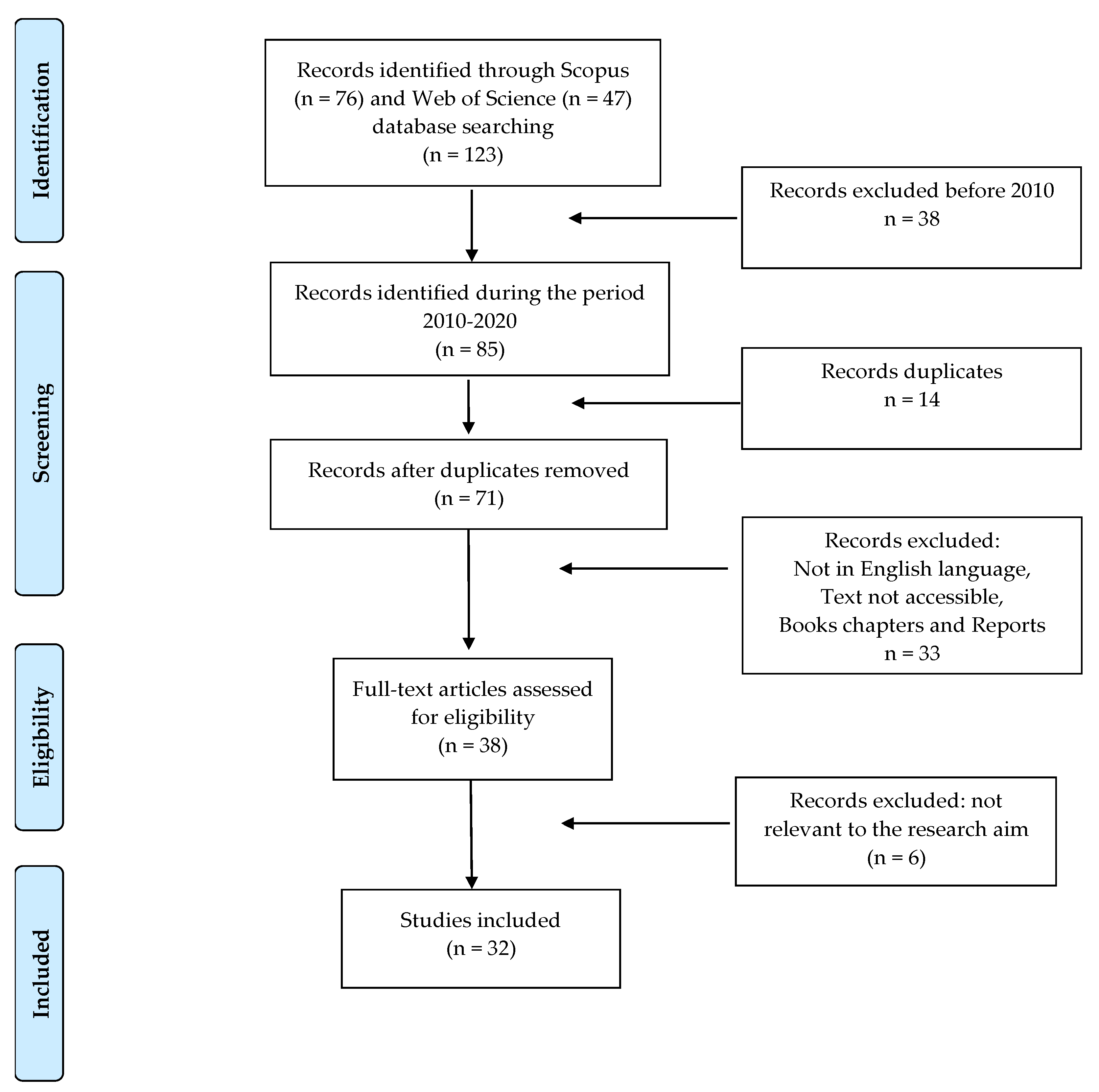
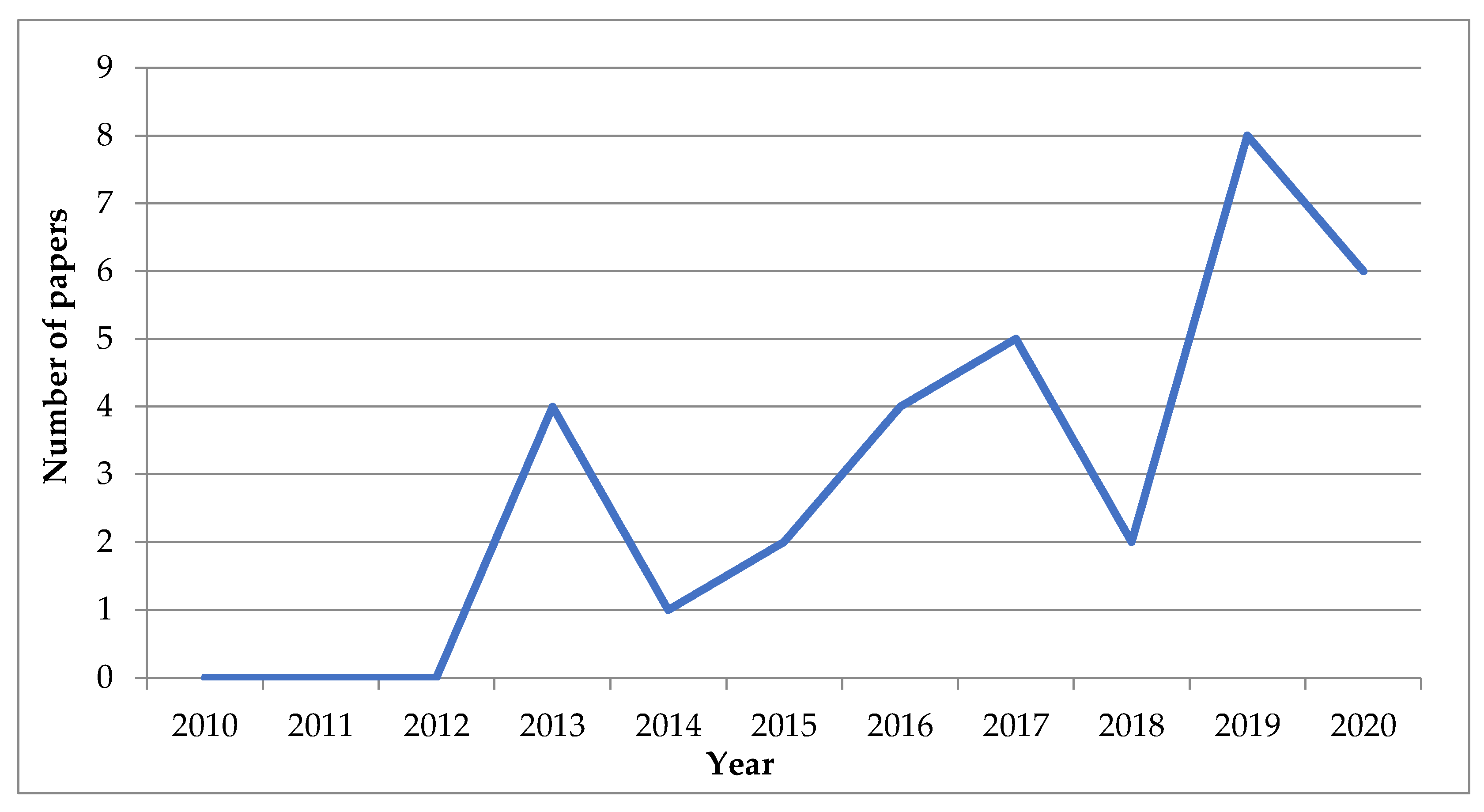
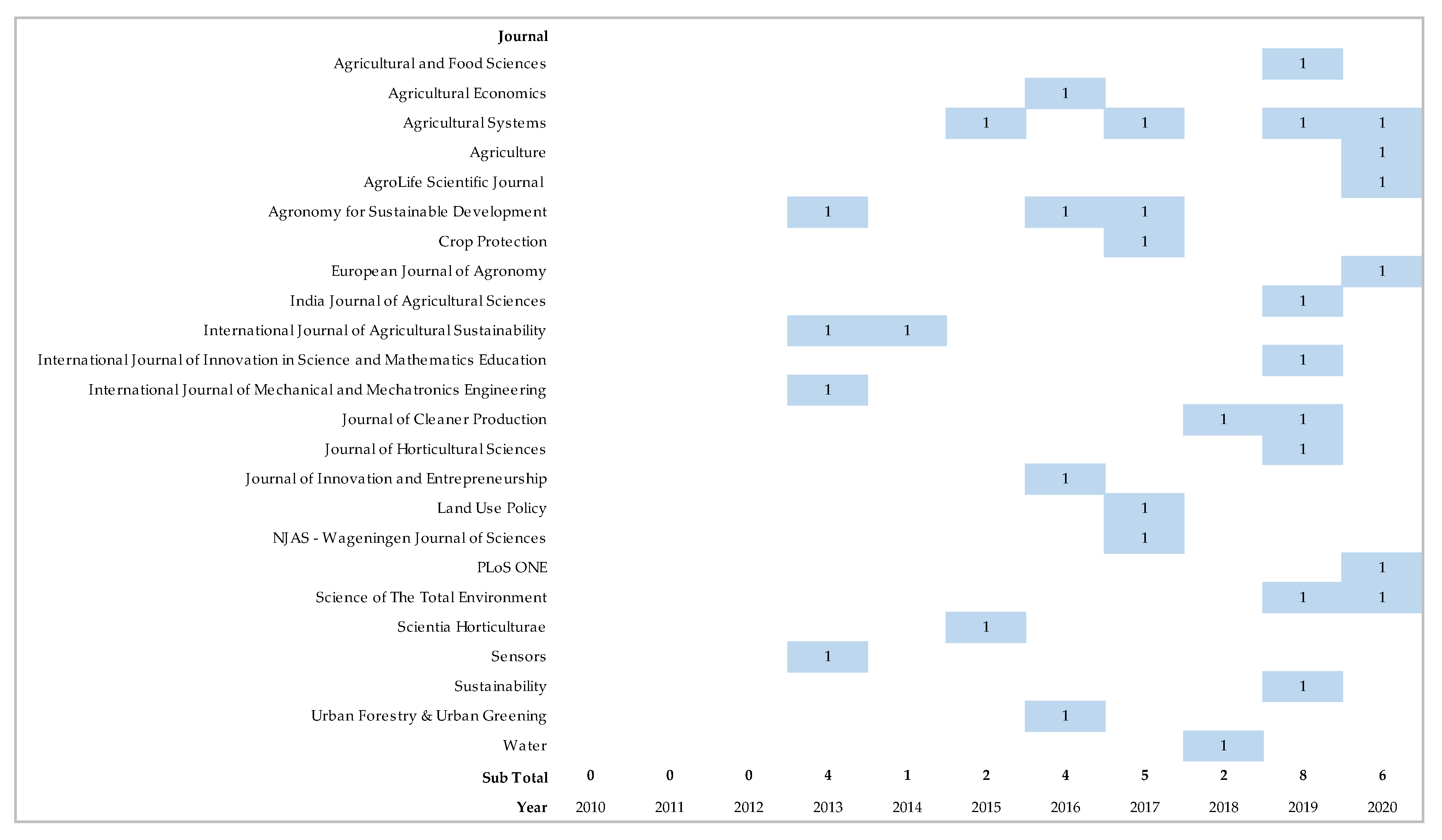
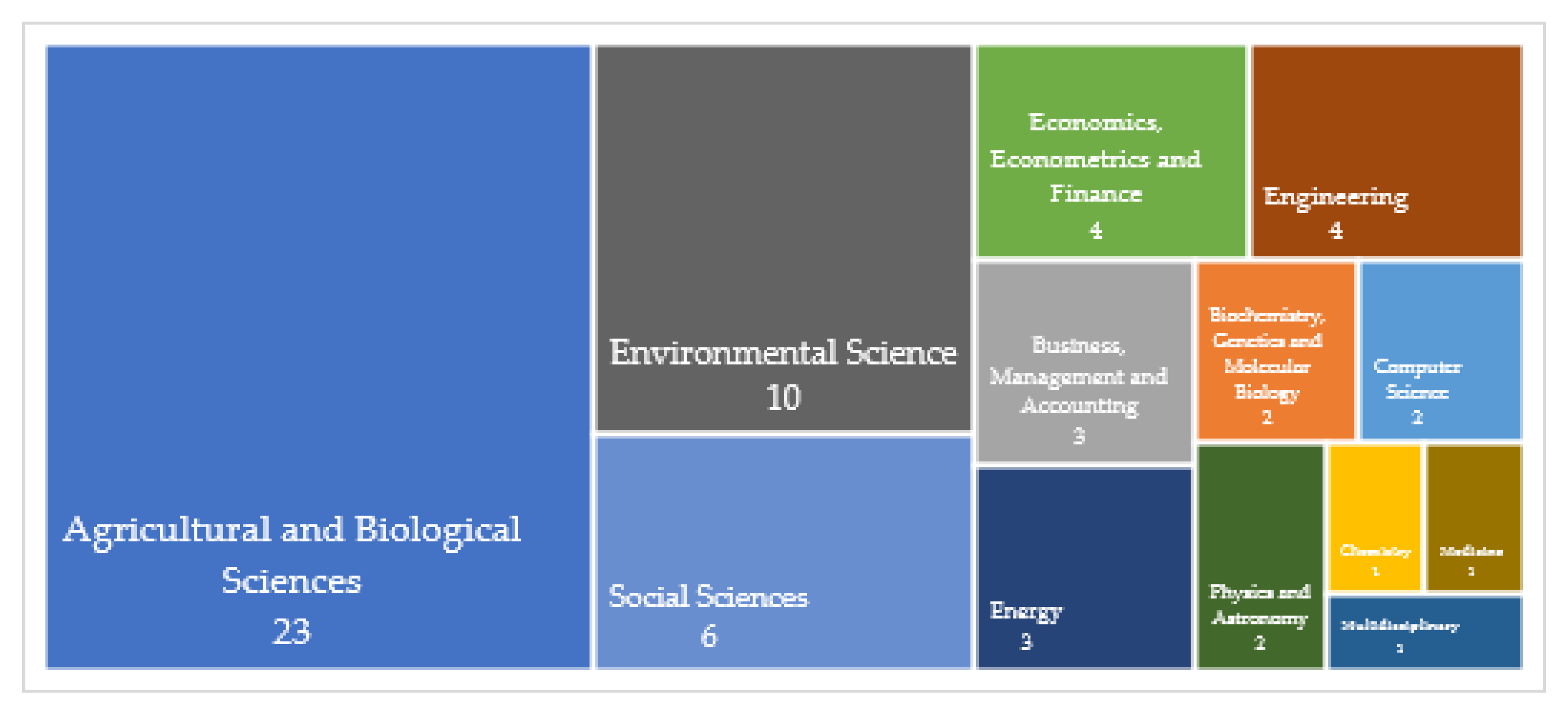
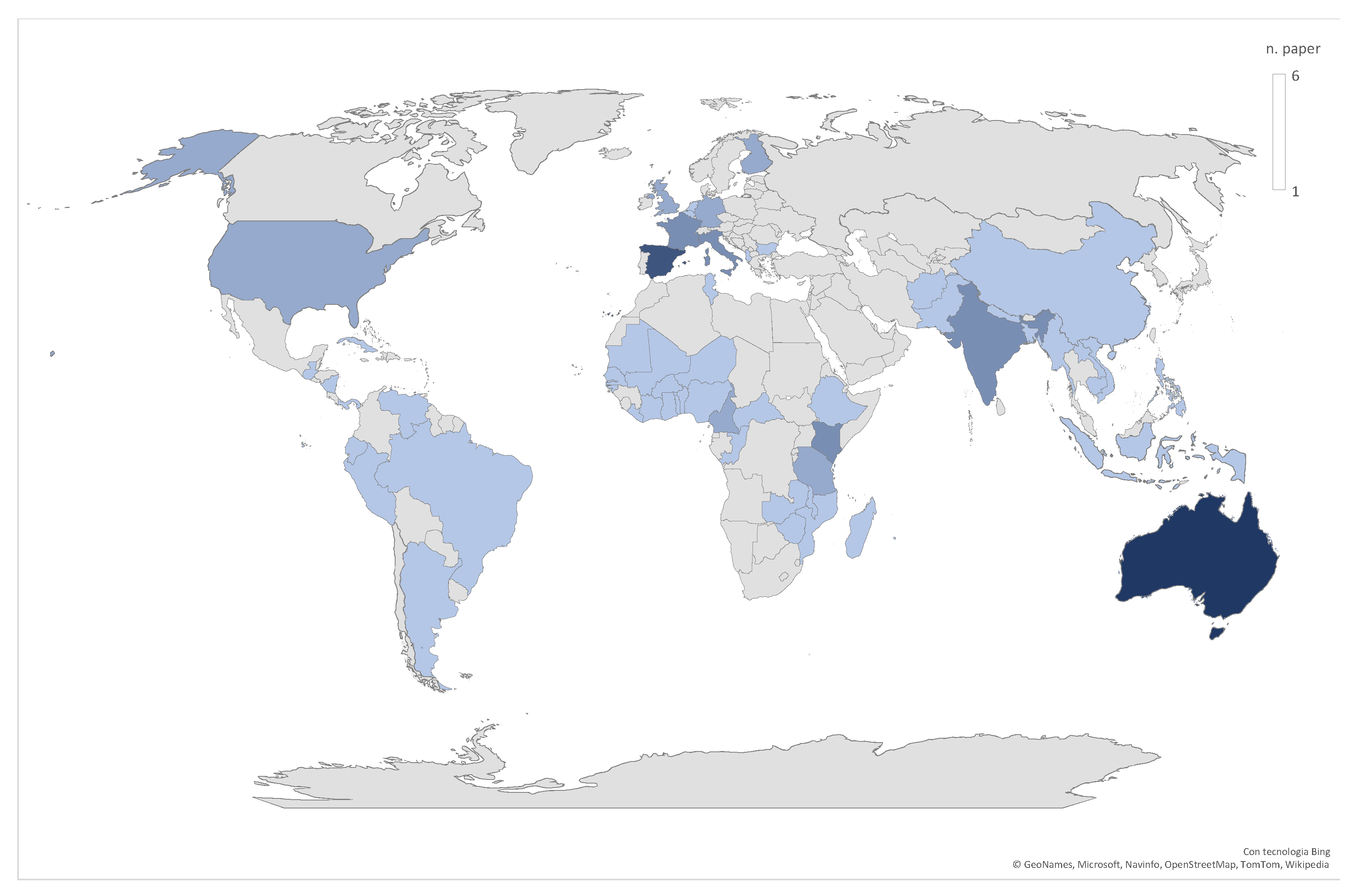
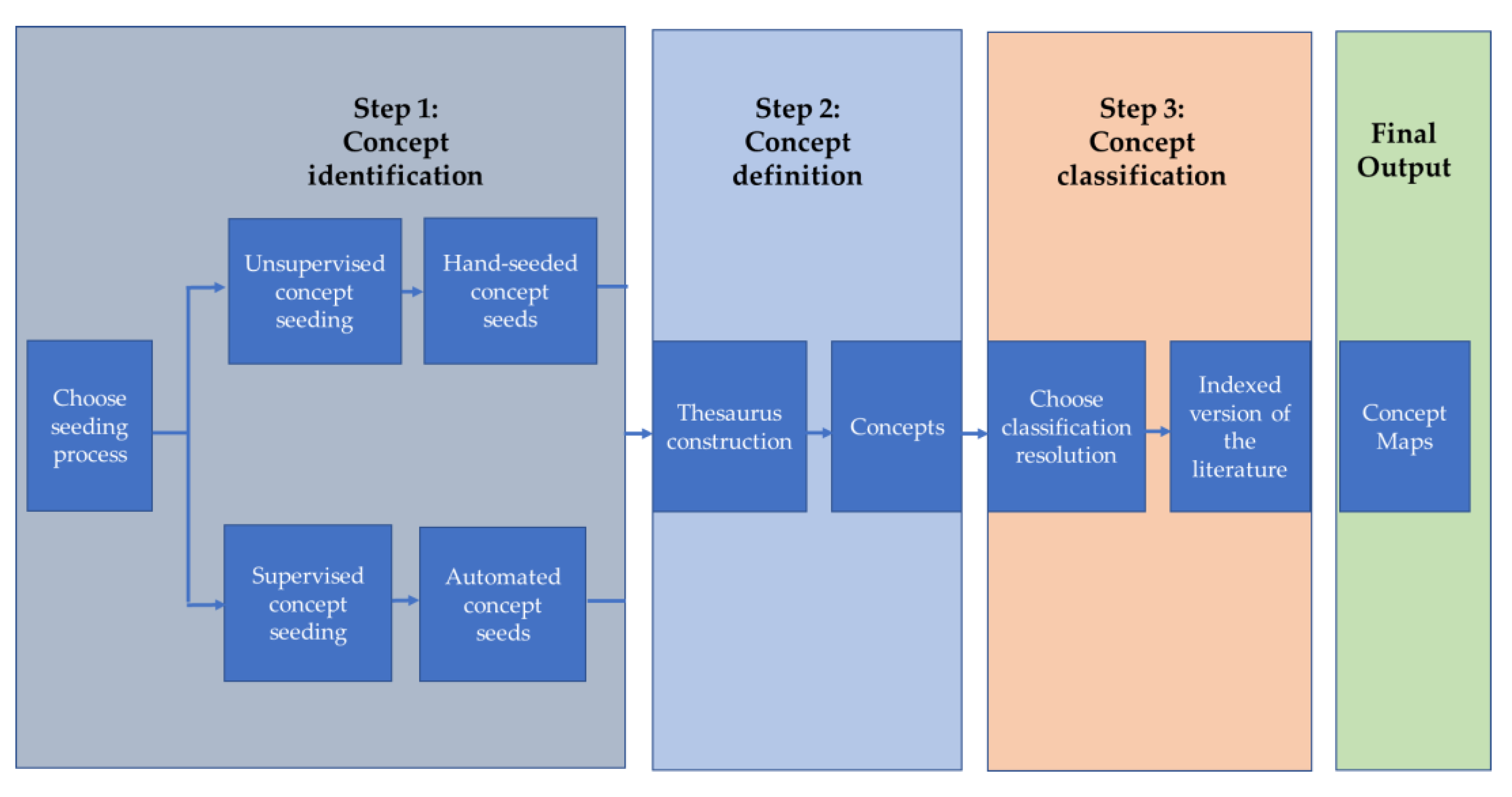
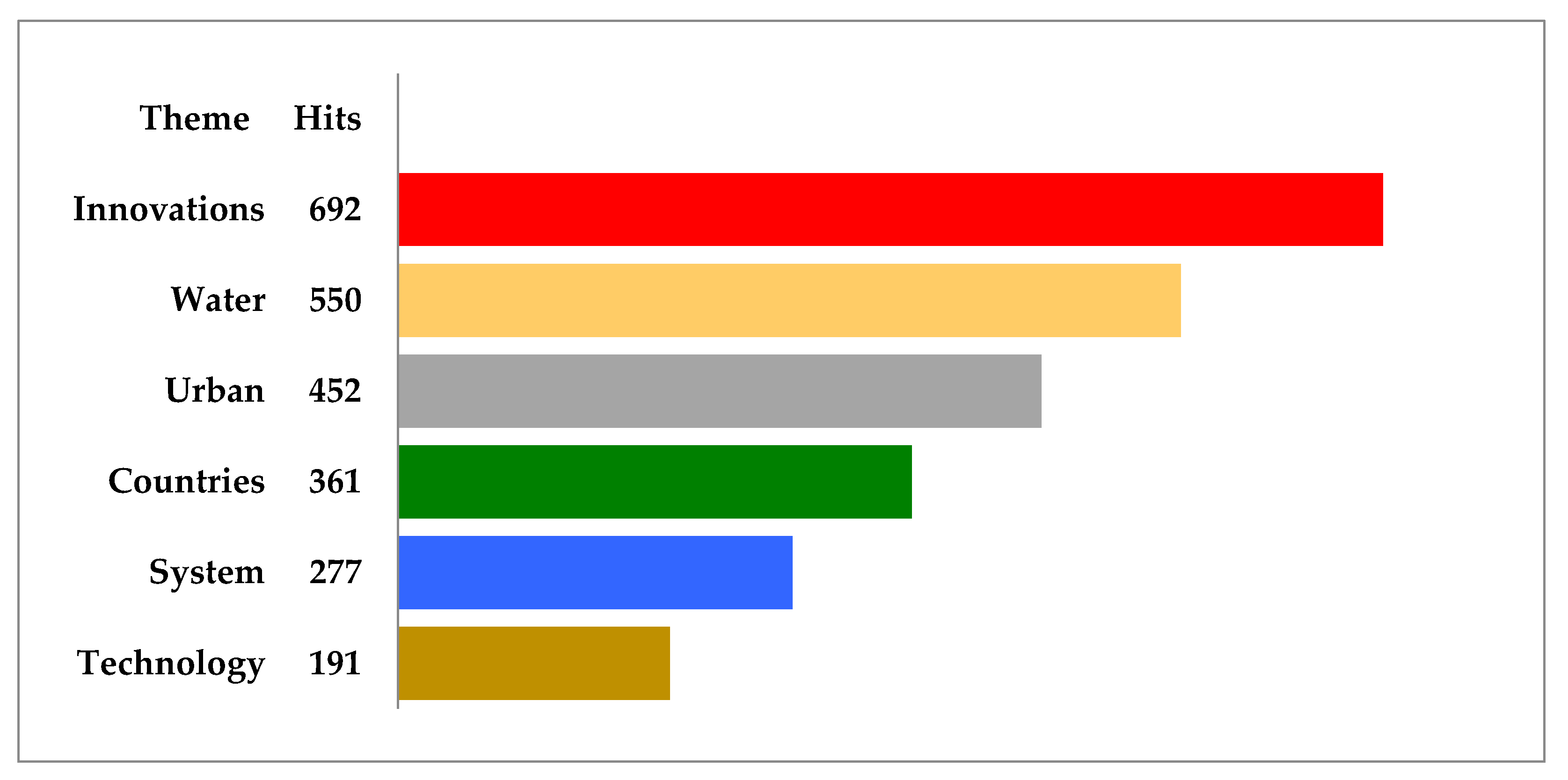
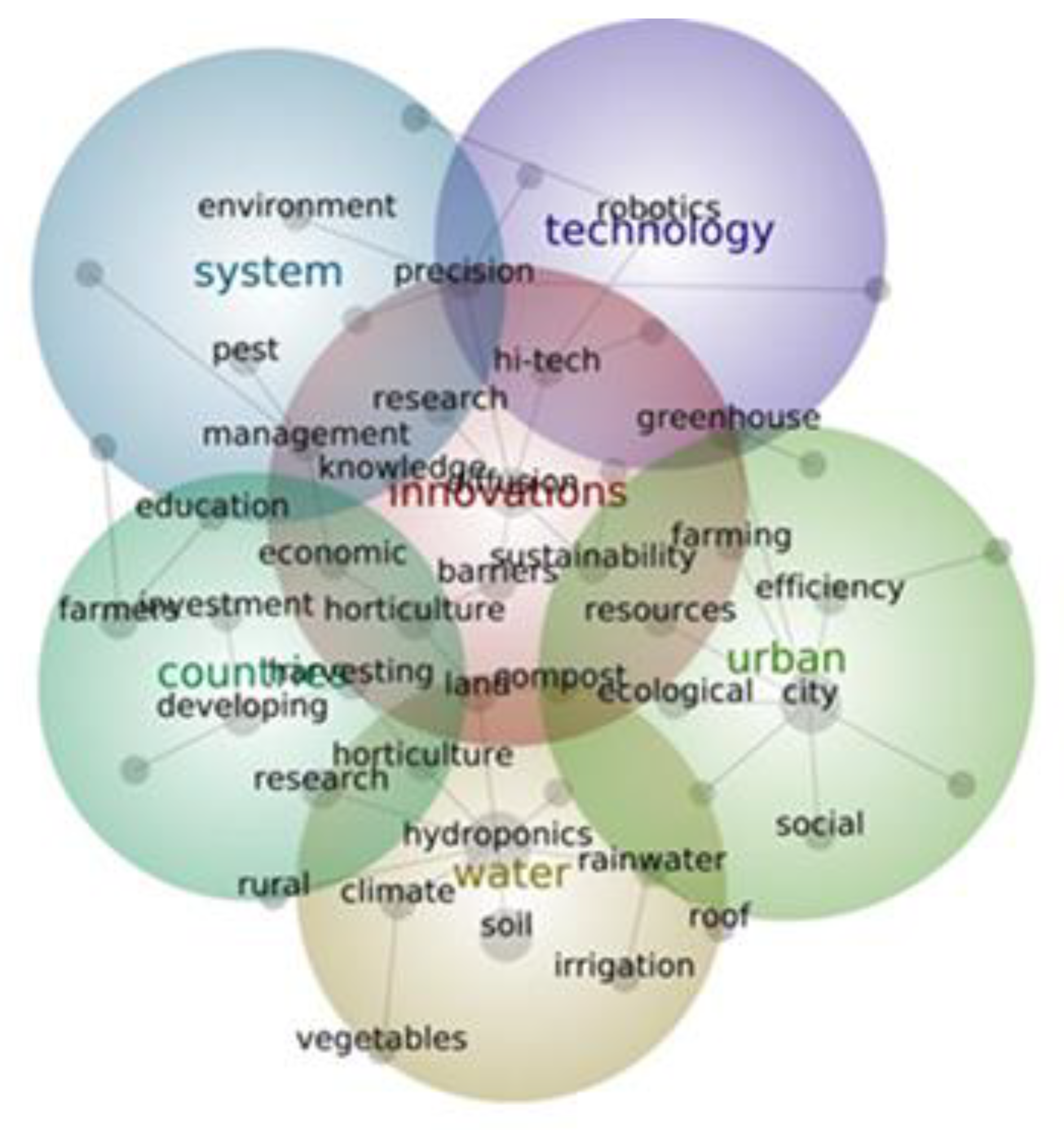
Publisher’s Note: MDPI stays neutral with regard to jurisdictional claims in published maps and institutional affiliations. |
© 2021 by the authors. Licensee MDPI, Basel, Switzerland. This article is an open access article distributed under the terms and conditions of the Creative Commons Attribution (CC BY) license (https://creativecommons.org/licenses/by/4.0/).
Share and Cite
Spina, D.; Vindigni, G.; Pecorino, B.; Pappalardo, G.; D’Amico, M.; Chinnici, G. Identifying Themes and Patterns on Management of Horticultural Innovations with an Automated Text Analysis. Agronomy 2021, 11, 1103. https://doi.org/10.3390/agronomy11061103
Spina D, Vindigni G, Pecorino B, Pappalardo G, D’Amico M, Chinnici G. Identifying Themes and Patterns on Management of Horticultural Innovations with an Automated Text Analysis. Agronomy. 2021; 11(6):1103. https://doi.org/10.3390/agronomy11061103
Chicago/Turabian StyleSpina, Daniela, Gabriella Vindigni, Biagio Pecorino, Gioacchino Pappalardo, Mario D’Amico, and Gaetano Chinnici. 2021. "Identifying Themes and Patterns on Management of Horticultural Innovations with an Automated Text Analysis" Agronomy 11, no. 6: 1103. https://doi.org/10.3390/agronomy11061103
APA StyleSpina, D., Vindigni, G., Pecorino, B., Pappalardo, G., D’Amico, M., & Chinnici, G. (2021). Identifying Themes and Patterns on Management of Horticultural Innovations with an Automated Text Analysis. Agronomy, 11(6), 1103. https://doi.org/10.3390/agronomy11061103







